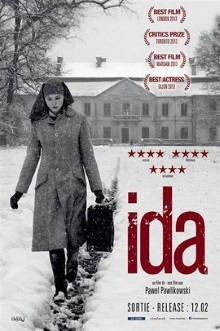
Despite technically being a 2013 release, Ida was seen by most critics in 2014 and consequently appeared in many lists of the best films of last year. Fifteen minutes in and it’s immediately apparent why so many critics loved it. Every shot in this film is composed with such exquisite care that every frame of it could stand alone as a work of art. Whether it’s a close-up shot of a face in a moving car, a girl walking on the stairs or a cabin in the snow, each scene shows as much craft as a painting. It’s just astounding.
It is equally apparent that this film is as visually striking as it is only because it is filmed entirely in black and white. Recently someone started a thread on Broken Forum, partly in jest I’m sure, questioning why anyone would want to take black and white photographs in this day and age. Suffice to say, he got thoroughly schooled but if any more evidence is needed, Ida makes for a fantastic case study. The richness of all of the details, including the contours in the grain of the cabin’s wood, the lines on the faces, the many individual leaves of the trees, are all brought out by the stark contrast of the black and white photography.
This does impart a kind of sterile austerity to the film, a quality that is compounded by director Pawel Pawlikowski’s decision to hold the audience at arm’s length. Yet this stylistic choice fits in well with the story of novice nun in Communist-era Poland. Raised as an orphan in a convent, she is asked to make contact with her only surviving family before she is allowed to take her vows. After meeting her aunt, she learns of her Jewish heritage and they decide to set out to find the graves of her parents.
It’s a harrowing tale that delves into Poland’s problematic relationship with the Germans during the Second World War and their guilt over their Jewish community. Yet despite the deeply personal nature of the story, the stark austerity of the presentation and enforced distance between the audience and the characters makes it feel oddly bloodless and intellectual while still lending it a sort of quiet power. This is especially evident during a couple of moments of horror that is powerfully shocking because everything else is so understated.
In a film as quiet as this, I found it hard to judge the acting ability of the performers. Certainly Agata Trzebuchowska is at least competent in the titular role in what appears to be her debut. But while this is Ida’s story, I found the character of her aunt Wanda Gruz, as played by Agata Kulesza to be more interesting. I think it is a pity that the film, which is actually surprisingly short, didn’t spend more time on this formidable woman who apparently left her family to fight during the war and later served as a prosecutor against war crimes under the Soviet-controlled regime. Even right up to the end, Ida seemed indifferent about her Jewish heritage while it clearly mattered a great deal to her aunt however much she makes light of it.
While I wouldn’t rank Ida as my favorite film of the year since I prefer films that either more original or have a more substantial plot than this, it is certainly among the best of the year and should be required watching if only for the amazing photography alone.
One thought on “Ida (2013)”